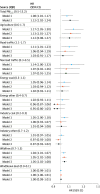Comparison of Particulate Air Pollution From Different Emission Sources and Incident Dementia in the US
- PMID: 37578757
- PMCID: PMC10425875
- DOI: 10.1001/jamainternmed.2023.3300
Comparison of Particulate Air Pollution From Different Emission Sources and Incident Dementia in the US
Abstract
Importance: Emerging evidence indicates that exposure to fine particulate matter (PM2.5) air pollution may increase dementia risk in older adults. Although this evidence suggests opportunities for intervention, little is known about the relative importance of PM2.5 from different emission sources.
Objective: To examine associations of long-term exposure of total and source-specific PM2.5 with incident dementia in older adults.
Design, setting, and participants: The Environmental Predictors of Cognitive Health and Aging study used biennial survey data from January 1, 1998, to December 31, 2016, for participants in the Health and Retirement Study, which is a nationally representative, population-based cohort study in the US. The present cohort study included all participants older than 50 years who were without dementia at baseline and had available exposure, outcome, and demographic data between 1998 and 2016 (N = 27 857). Analyses were performed from January 31 to May 1, 2022.
Exposures: The 10-year mean total PM2.5 and PM2.5 from 9 emission sources at participant residences for each month during follow-up using spatiotemporal and chemical transport models.
Main outcomes and measures: The main outcome was incident dementia as classified by a validated algorithm incorporating respondent-based cognitive testing and proxy respondent reports. Adjusted hazard ratios (HRs) were estimated for incident dementia per IQR of residential PM2.5 concentrations using time-varying, weighted Cox proportional hazards regression models with adjustment for the individual- and area-level risk factors.
Results: Among 27 857 participants (mean [SD] age, 61 [10] years; 15 747 [56.5%] female), 4105 (15%) developed dementia during a mean (SD) follow-up of 10.2 [5.6] years. Higher concentrations of total PM2.5 were associated with greater rates of incident dementia (HR, 1.08 per IQR; 95% CI, 1.01-1.17). In single pollutant models, PM2.5 from all sources, except dust, were associated with increased rates of dementia, with the strongest associations for agriculture, traffic, coal combustion, and wildfires. After control for PM2.5 from all other sources and copollutants, only PM2.5 from agriculture (HR, 1.13; 95% CI, 1.01-1.27) and wildfires (HR, 1.05; 95% CI, 1.02-1.08) were robustly associated with greater rates of dementia.
Conclusion and relevance: In this cohort study, higher residential PM2.5 levels, especially from agriculture and wildfires, were associated with higher rates of incident dementia, providing further evidence supporting PM2.5 reduction as a population-based approach to promote healthy cognitive aging. These findings also indicate that intervening on key emission sources might have value, although more research is needed to confirm these findings.
Conflict of interest statement
Figures


References
-
- US Environmental Protection Agency . Integrated Science Assessment (ISA) for Particulate Matter (Final Report, December 2019). Accessed June 30, 2023. https://cfpub.epa.gov/ncea/isa/recordisplay.cfm?deid=347534
-
- Lai W, Li S, Li Y, Tian X. Air pollution and cognitive functions: evidence from straw burning in China. Am J Agric Econ. 2022;104(1):190-208. doi:10.1111/ajae.12225 - DOI
Publication types
MeSH terms
Substances
Grants and funding
LinkOut - more resources
Full Text Sources
Medical

